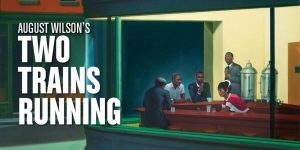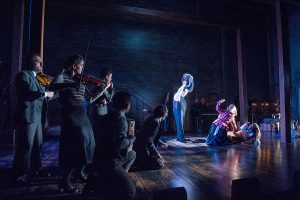Stretching backstage and out of sight, the road—Mother Road—appears to last forever. It is the context for every event to unfold for the next two and a half hours, and it is immediately striking upon entry to the Fichandler Stage. The play’s program lists the setting as “on the Mother Road between Arvin, California and Sallisaw, Oklahoma.” Even in moments not set literally on Mother Road, she is always there.
Octavio Solis’s Mother Road, running through Mar. 8 at Arena Stage, is a generations-later continuation of John Steinbeck’s 1939 novel The Grapes of Wrath. First produced in early 2019, the play follows the last living members of the Joad family as they go on a journey from California to the family’s Oklahoma farm, which has been left in the hands of William Joad (Mark Murphey) for decades. He searches for someone who shares his blood to run the farm, as he knows he will soon be unable to do so. Martín Jodes (Tony Sancho), a Mexican-American migrant worker in California, just happens to be the last remaining Joad relative. He is the great-grandson of William’s cousin, and as he comes from a Mexican family, he is not what William expects or wants a Joad to be.
Like Steinbeck, Solis has a vision for commentary regarding the lives of the working class. This vision, reimagined for the modern stage, focuses largely on Latinx migrant workers and their experiences as being part of both the working class and a minority group. Martín describes, at many points, his experiences and struggles with his work and its fleeting nature. In a strikingly heartbreaking moment, he details the abuse his mother faced as a migrant worker.
Every moment of the show is loaded, with discussions of immigration policies, police violence, and the pervasive mistreatment of Latinx people by government bodies like Immigration and Customs Enforcement (ICE). Martín, someone intrinsically motivated by a sense of justice, struggles with these issues throughout the play. William suffers from terminal cancer, a very present and recurring reality. There are moments of long-lasting grief, intense violence, and unexpected tragedy.
While the play maintains an overall sense of seriousness and gravity, there are specific moments of levity as well. Director Bill Rauch’s work with the text is at once fun and poignant. The staging is lyrical and minimal, with a chorus of ensemble members who hum, sing, and take the form of many people as well as inanimate objects. They are waitresses and strangers, television sets and jukeboxes, and they are even the road itself. Members of this chorus whisper “mile marker,” “mile marker,” on and on as the Joads and their companions make their way down the road. At the same time, many of the choral moments speak to traumas and the experiences of migrant workers.
The duality of comedy and tragedy is not the only one Mother Road finds flawlessly. Due to the play’s relation to and inspiration from The Grapes of Wrath, it works as both a modern commentary and a historical literary narrative. William tells stories of his youth in Oklahoma during the Dust Bowl, and the staging of these moments transports the Fichandler from present-day to the 1930s. Lights design and projections bring the natural world beyond the road to the theater space, creating the effect of dangerous dust clouds blowing around incessantly. This moment brings an ecological tragedy from the past to the here and now, reminiscent of current discussions regarding impending environmental catastrophes.
Much of the play’s imagery and use of technology are distinctly new, though. As the Joads and their companions travel, projections emphasize the road’s nature and give the illusion of quick motion, as if audiences peer, at times, out the window of a fast-moving car. Pablo Santiago, the lighting designer for the production, worked closely with projection designer, Kaitlyn Pietras, to create this complex element. “The opacity of the projection is such that it feels like it’s embedded in the light, but the actual effect of those lines streaking through the road is actually the projection,” Santiago said. The design team brought together elements like these seamlessly.
An emotional journey happens throughout the physical one from California to Oklahoma, and every piece of the play, including technical aspects, supports it. The lightscape gets darker and generally messier, with numerous colors involved to make the light more pervasive and complex, mimicking the show’s buildup and the change in characters’ relationships. “Our journey is to illuminate that sort of complexity,” Santiago said.
Combining stories steeped in history with realistic and believable modernity, Mother Road emphasizes the long-lasting nature of every question it asks. At its core, the play contends with themes of family, nationality, land ownership, and legacy. It asks us what it really means to be American, and leaves us with the answer that anyone can be. The story arc brings two men, connected by blood and eventually by identity, together.





